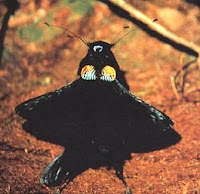Bird of Paradies Part-1

There are more than three dozen species in the family Paradisaeidae, more commonly known as the birds of paradiseMost are distinguished by striking colors and bright plumage of yellow, blue, scarlet, and green. These colors distinguish them as some of the world's most dramatic and attractive birds. The facts about these birds are as extra-ordinarily as their mythology. All in all there are 43 species and they live in the remote mountainous jungle of New Guinea. Any self-respecting highlanders used these feathers for his or hers decoration. Scientist think they are distance cousins of starlings. Their sizes are from thrush to crow.These birds also lend their name to a colorful flower. South Africa's bird-of-paradise (Strelitzia reginae) is a member of the banana family. It sports a beautiful flower believed to resemble the avian bird of paradise in flight.The name 'Birds of Paradise' came from the idea that they floated in heavenly paradise and therefore don't need any wings or limbs. Because the birds were so illusive that they were only found when they died and fell to earth. That is when the highlanders of New Guinea found the birds, hence the belief. A further reason gave the belief credibility that the highlanders presented the birds with the feathers on the skin and no wings . These birds are rarely seen and especially when they display their plumes in courtship.Birds of paradise are found in New Guinea and surrounding islands. The manucodes and riflebirds species also dwell in Australia. Birds of paradise are so attractive that their appearance once made them the target of skin hunters, who decimated some species.

WESTERN PAROTIA:-
The male is more colorfull than the female.
 The western parotia is a blackbird with a shining top on its head. It clears the floor and when the female surround him he starts to dance. At first he hops around strangely. When it gets more exited it spread his feather to create a cloak. Then he bobs up and down and hops on the spot, at the same time jerking its head from side to side to whirl a ring of quills which stick out of its head.The whole performance is so unlike a bird's behaviour but the female seemed to be impressed and the best dancers get the lady. Furthermore, the juveniles practising before they watch the masters. They spent several years before their dance routine is perfect. Then they too take the centre stage.The traders brought these feathers back since the 15th century to Europe. The real climax came in the 19th century when it was the most fashionable thing to decorate the bonnets with the feather of the these birds.
The western parotia is a blackbird with a shining top on its head. It clears the floor and when the female surround him he starts to dance. At first he hops around strangely. When it gets more exited it spread his feather to create a cloak. Then he bobs up and down and hops on the spot, at the same time jerking its head from side to side to whirl a ring of quills which stick out of its head.The whole performance is so unlike a bird's behaviour but the female seemed to be impressed and the best dancers get the lady. Furthermore, the juveniles practising before they watch the masters. They spent several years before their dance routine is perfect. Then they too take the centre stage.The traders brought these feathers back since the 15th century to Europe. The real climax came in the 19th century when it was the most fashionable thing to decorate the bonnets with the feather of the these birds.
 The western parotia is a blackbird with a shining top on its head. It clears the floor and when the female surround him he starts to dance. At first he hops around strangely. When it gets more exited it spread his feather to create a cloak. Then he bobs up and down and hops on the spot, at the same time jerking its head from side to side to whirl a ring of quills which stick out of its head.The whole performance is so unlike a bird's behaviour but the female seemed to be impressed and the best dancers get the lady. Furthermore, the juveniles practising before they watch the masters. They spent several years before their dance routine is perfect. Then they too take the centre stage.The traders brought these feathers back since the 15th century to Europe. The real climax came in the 19th century when it was the most fashionable thing to decorate the bonnets with the feather of the these birds.
The western parotia is a blackbird with a shining top on its head. It clears the floor and when the female surround him he starts to dance. At first he hops around strangely. When it gets more exited it spread his feather to create a cloak. Then he bobs up and down and hops on the spot, at the same time jerking its head from side to side to whirl a ring of quills which stick out of its head.The whole performance is so unlike a bird's behaviour but the female seemed to be impressed and the best dancers get the lady. Furthermore, the juveniles practising before they watch the masters. They spent several years before their dance routine is perfect. Then they too take the centre stage.The traders brought these feathers back since the 15th century to Europe. The real climax came in the 19th century when it was the most fashionable thing to decorate the bonnets with the feather of the these birds.

No comments:
Post a Comment